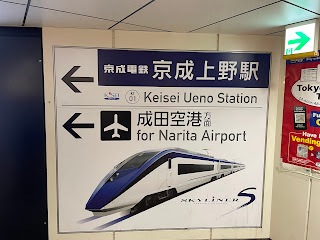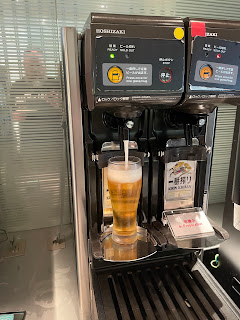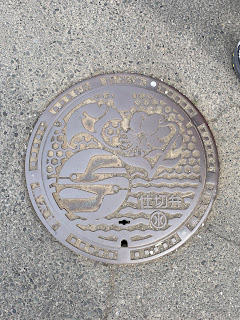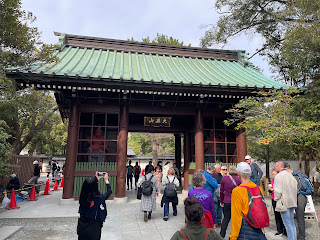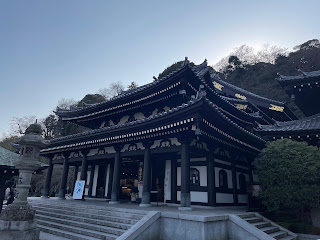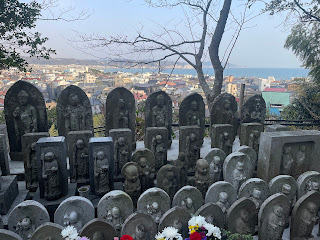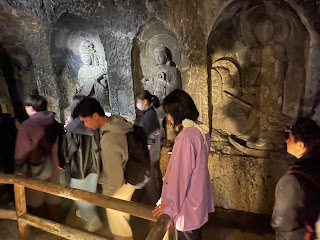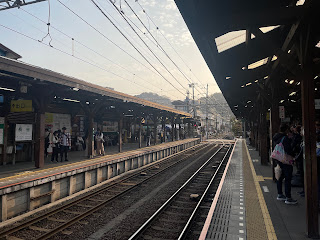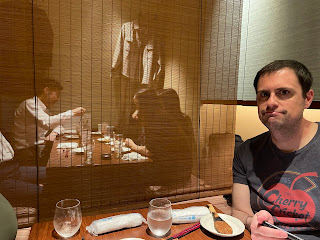Cherry blossom season officially started yesterday, in Tokyo. Michael and Sarah had gone to a park full of them yesterday, but were underwhelmed by the blossoms. I think they went out again this morning in search of more trees.
Sabrina and I got breakfast at the hotel restaurant and then went back up to the room to pack. We'd walked something like 140 or 150 miles in the past two weeks, and probably had a few more to walk today yet.
Our stay had included breakfast tickets for every day, and we hadn't used them the day we went to Nikko; the fine print said they were also valid for a lunch on weekdays, so we met for one last meal at the hotel restaurant after checking out.
The "meat plate" was the real wildcard. The description in English said something "Alsatian style chicken", which turned out to be a chicken cutlet covered in ground beef, topped with bacon and panko.
After lunch, we took the Ginza subway line over to Ueno station, then switched to the Skyliner train out to NRT airport.
The airport wasn't too crazy yet, and their security is fast and efficient, so we had plenty of time to shop and such. In case anyone needed convincing that the Japanese are serious about their tea, Narita airport has hot-water dispensers next to the drinking fountains.
Our friends had upgraded their seats again, which gave them lounge access and also one guest each. With a few hours to kill, we decided to check out the ANA lounge.
It's the first place I've seen a delivery robot being used to bring dishes back to the kitchen.
One of the selling points of the ANA lounge is that they have a noodle bar, in addition to the usual food options.
They also had a wide variety of sake available, depending on how expensive your seat was.
After an hour or so, we got bored of the ANA lounge and switched to the United lounge.
They didn't have a noodle bar, but they did have takoyaki.
The United lounge was close to our gate, so we enjoyed the (relative) peace and quiet for as long as possible.
Our flight departed at 5:45 PM. It's just over a 12 hour flight, with a 13 hour time change across the International Date Line... so we landed almost an hour before we left.
In no particular order, here are a few things that I'd like to remember for any future trips. Some of these we'd known ahead of time, either from a guidebook or advice from friends who had recently been to Japan, and some we discovered over the last two weeks.
- The JR Pass wasn't worth the cost for us, as there are many cases it doesn't cover and it got much more expensive in the last year or so. It might be worthwhile if you're planning extensive intra-city rail travel, but figuring out if it's a financial win is tricky.
- The IC transit card was a perfect option for us. We went with the tourist version, called "Welcome Suica", and it worked literally on every method of transit we used except Shinkansen (subways, local trains/trams, multiple different intra-city rail lines, cable cars, ferry, bus) in every city we visited.
- It can also be used to buy food at train stations, drinks from vending machines, anything from 7-Eleven, and souvenirs at the airport.
- While it was possible to purchase at HND airport using credit, it can only be refilled using cash. But it can be refilled at any train/subway station, and probably more places.
- Any remaining balance is lost when you leave, though (thus, spend at airport).
- The card is only valid for 28 days, meaning you can't pass it along to friends or use it on a later trip. (There may be other IC cards that don't have this limitation.)
- Trying to buy a train ticket without using a transit card is incredibly difficult, as most options are self-serve kiosk only, and they did not seem particularly user-friendly.
- It might be possible to just use a credit card or a smartphone with Google/ApplePay in place of a transit card, but this was unclear. It might only have been possible outside of Tokyo?
- Public restrooms are ubiquitous, clean, free, and almost entirely without paper towels. A rare few had Toto/similar hand dryers, but in general, expect to carry your own small towel or get used to wiping wet hands on your clothing. Almost none of them had hot water, either.
- Public trash cans are nonexistent. If you're lucky, a train platform might have one. Convenience stores and takeout restaurants sometimes had them available, but really only for trash from their stores. Get used to keeping a bag of trash with you, to bring back to the hotel or wherever.
- Eating while walking was expressly forbidden in most areas we went, with the possible exception of Miyajima. The expectation is that you stand in front of the vendor where you bought street food and eat it there, or carry it somewhere else (like to a park) and eat it there.
- Drinking while walking is fine, as there are vending machines everywhere. The vending machines often had accompanying recycling buckets, but if you get a coffee to go, be prepared to carry that empty cup around for an hour or two.
- Food was shockingly cheap, especially outside of Tokyo. We were not eating at high-end restaurants, but could easily get dinner for under $15 equivalent, per person (and under $10 for lunch). Expect to pay a little bit more to dine in at a place that also does takeout. There is no tipping.
- The star ratings in Google Maps are effectively on a different scale than in the US; while people seem to consider anything under 4 stars to be off limits at home, only very expensive restaurants rated in the mid-to-high 4s in Japan. Most restaurants were in the mid-to-high 3-star range.
- Every major train station is attached to a shopping mall, essentially. There are decent restaurants, sometimes food courts, almost always bakeries, etc.
- Convenience stores are literally everywhere. 7-Eleven has more stores in Japan than Starbucks has locations in the United States. There was a 7-Eleven within a block of our hotel in Tokyo, in two different directions on the same street. Most train stations had at least one, and some had multiple. There are also Lawson and FamilyMart chains that are functionally equivalent.
- If you can't be bothered to carry a water bottle, you'd still have no problem staying hydrated. I've never seen so many vending machines, anywhere. And they're all cheap, like a bottle of water for $1 or less. Even on the way up to a mountaintop shrine, there are vending machines selling drinks.
- Tokyo is absolutely enormous. Things that look nearby on a map can easily be 30 or 40 minutes by train (or multiple trains). The subway map and this page comparing the Yamanote line to other cities helps convey the scale of things, I think.
- Visitors have to fill out an online form to get through immigration. If you don't have the QR code from this process, they'll hand out paper forms on the plane but it was much easier to do ahead of time.
- Sabrina and I had very good experiences using an eSIM service for data while in Japan. After more research than was probably necessary, I settled on using Ubigi; it was simple and we never had a problem with it. I didn't even use 3GB of data in two weeks, but had purchased 10GB in bulk because it was cheap. If for some reason you want to use it, the referral code "J7R9CEG9" gets you 20% off. The eSIMs all seemed to be data-only (meaning you don't get a phone number, so no SMS but iMessage, FaceTime, and WiFi calling worked with some fiddling).
- All of the temples/shrines that charge admission are cash-only. Many street food vendors, and some restaurants, are also cash-only. The exchange rate of about 150 yen per $1 means that you can convert yen to USD by dividing by 100 and then taking 2/3 of the number (e.g., 1200 yen is about $8).
- While transit is fairly cheap, we used taxis a number of times and found them to be quite cheap too (especially when splitting four ways). There is no Uber/equivalent, but there is some way to use Uber to get a taxi I think. We just had hotel desks call us taxis, when applicable, or waived one down outside a train station. I think you're supposed to go to the taxi stand, but this didn't seem to be enforced. Every taxi we used took payment by credit card, also.
Resources that we used for planning, in addition to itineraries from several friends:
- https://www.timeout.com/japan/travel/japan-two-week-train-itinerary
- https://www.ricksteves.com/travel-tips/travel-classes/monday-night-travel/japan
- https://jonellepatrick.com/the-tokyo-guide-i-wish-id-had/
- https://nerdnomads.com/travel/asia/japan
- https://www.japan-guide.com/
- https://www.theinvisibletourist.com/2-weeks-in-japan-itinerary-first-time/
- https://www.jrailpass.com/blog/10-days-japan-itinerary
- https://apassionandapassport.com/10-days-in-japan-a-first-timers-complete-itinerary/
- https://www.lonelyplanet.com/articles/best-japan-itineraries

